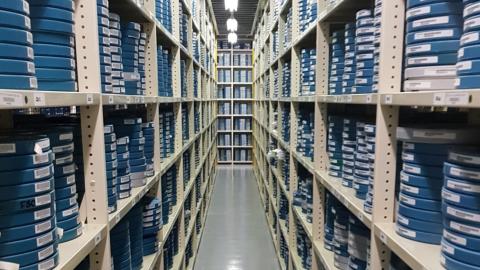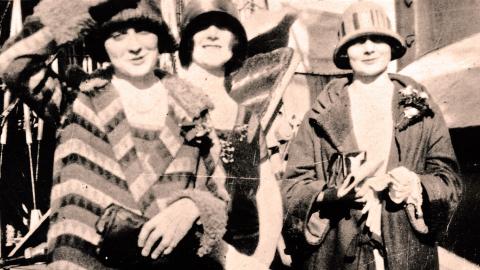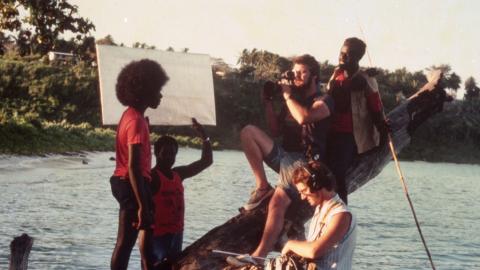
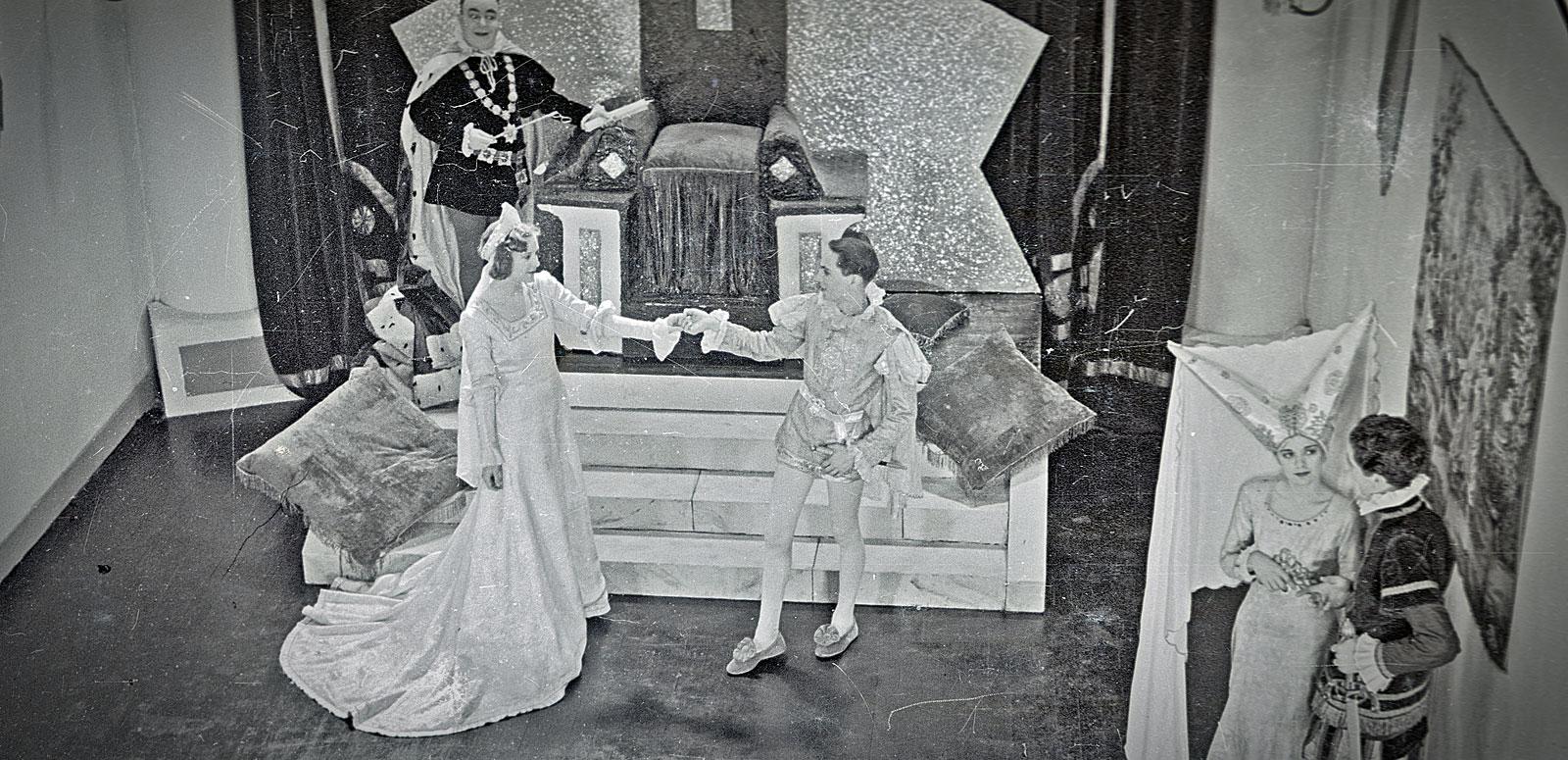
NFSA's most wanted
Image: The Magic Shoes (1935). NFSA ID: 683091
Our curators continually search for key works to fill vital gaps in the NFSA collection.
Below is the current list of works we are actively seeking.
If you have any of these or rare items related to Australia's audiovisual history, please contact enquiries@nfsa.gov.au. We look forward to hearing from you.
Search current NFSA collections using title numbers or keywords.
First Nations
- Posters, publicity and photographic works relating to First Nations musicians, actors, filmmakers and production companies.
Film
- Across Australia with Francis Birtles (Francis Birtles, Richard Primmer, Australia, 1912). This film covered adventurer Birtles’ epic bicycle ride from Sydney to Darwin, including dramatised interaction between First Nations people and early white settlers.
- Every missing silent-era feature film directed by Franklyn Barrett, including Know Thy Child (Franklyn Barrett, Australia, 1921). Praised in its day for its subtle handling of the sensitive theme of illegitimacy, this adult drama featured class differences in an urban setting. See Know Thy Child material that the NFSA already holds.
- The Burgomeister (Harry Southwell, Australia, 1935). One sequence survives from this second Australian feature adaptation of the stage melodrama The Bells, the first having been directed by WJ Lincoln in 1911. NFSA title no: 39124
- Cinesound Varieties (Ken G Hall, Australia, 1934). Hall's 48-minute film, featuring well-known Australian musical and comedy stars, did well at the box office in Australia and England. It is now the only one of his dramatised works that is almost entirely lost. See Cinesound Varieties material the NFSA already holds.
- Fellers (Arthur Higgins and Austin Fay, Australia, 1930). One of Australia’s first parttalkies, a World War I drama that featured Arthur Tauchert, star of The Sentimental Bloke (Raymond Longford, Australia, 1919). See Fellers material the NFSA already holds.
- Jewelled Nights (Louise Lovely, Wilton Welch, Australia, 1925). Louise Lovely, Australia’s first major star of Hollywood films in the 1910s and early 1920s, returned home to co-direct and star in this film, which told of a woman fleeing marriage to work as a man in a remote mining district. NFSA title no: 65446
- Every missing silent-era feature film directed by Raymond Longford, including The Blue Mountains Mystery (Raymond Longford, Lottie Lyell, Australia, 1921), a murder mystery that made effective use of its Blue Mountains (NSW) setting and was praised for getting ‘off the beaten bush track’. See The Blue Mountains Mystery material the NFSA already holds.
- The Magic Shoes (Claude Fleming, Australia, 1936). This short film, a pantomime fantasy, featured the first screen appearance of future international star and Oscar-winner Peter Finch. See The Magic Shoes material the NFSA already holds.
- Red Sky at Morning (Hartney Arthur, Australia, 1944). Another Peter Finch film, with the then radio and stage actor playing an Irish political exile in colonial Australia. See Red Sky at Morning material the NFSA already holds.
- The Removalists (Tom Jeffrey, Australia, 1975). An incomplete release print, the soundtrack final mix and video copies of the film are all that survive of this film adaptation of David Williamson’s classic Australian stage play. A more complete version of the film survives on video. See The Removalists' material the NFSA already holds.
- Rock ‘n’ Roll (Lee Robinson, Australia, 1959). Short clips are all that survive of this feature-length documentary which covered a major Sydney Stadium concert featuring Johnny O’Keefe, the Delltones and visiting US pop star Fabian. NFSA title no: 340456
- Show Business (AR Harwood, Australia, 1938). Only rushes (various takes) from one minor scene survive from this backstage musical whose cast included a key Australian singer of the day, Barbara James. See Show Business material the NFSA already holds.
- The Story of the Kelly Gang (Charles Tait, Australia 1906). While we recently restored this film to a quarter of its original length, we remain in search of a complete original and negative print.See The Story of the Kelly Gang material the NFSA already holds.
- Symphony in Steel (Frank Hurley, Australia, 1932). Frank Hurley’s widely acclaimed documentary on the construction of the Sydney Harbour Bridge has vanished, despite its international release. See Symphony in Steel material the NFSA already holds.
- Two Minutes Silence (Paulette McDonagh, Australia, 1933). The last of four features directed by the Sydney-based Paulette McDonagh, Two Minutes Silence was adapted from an anti-war play by Leslie Haylen. McDonagh considered it the best film she ever made. See Two Minutes Silence material the NFSA already holds.
- Any film or sound recordings of Australia’s early Prime Ministers, especially John Christian Watson, of whom no known recording exists.
- Early documentary film of Australia’s connections with our region, including Papua New Guinea, Timor-Leste, Antarctica and the Pacific.
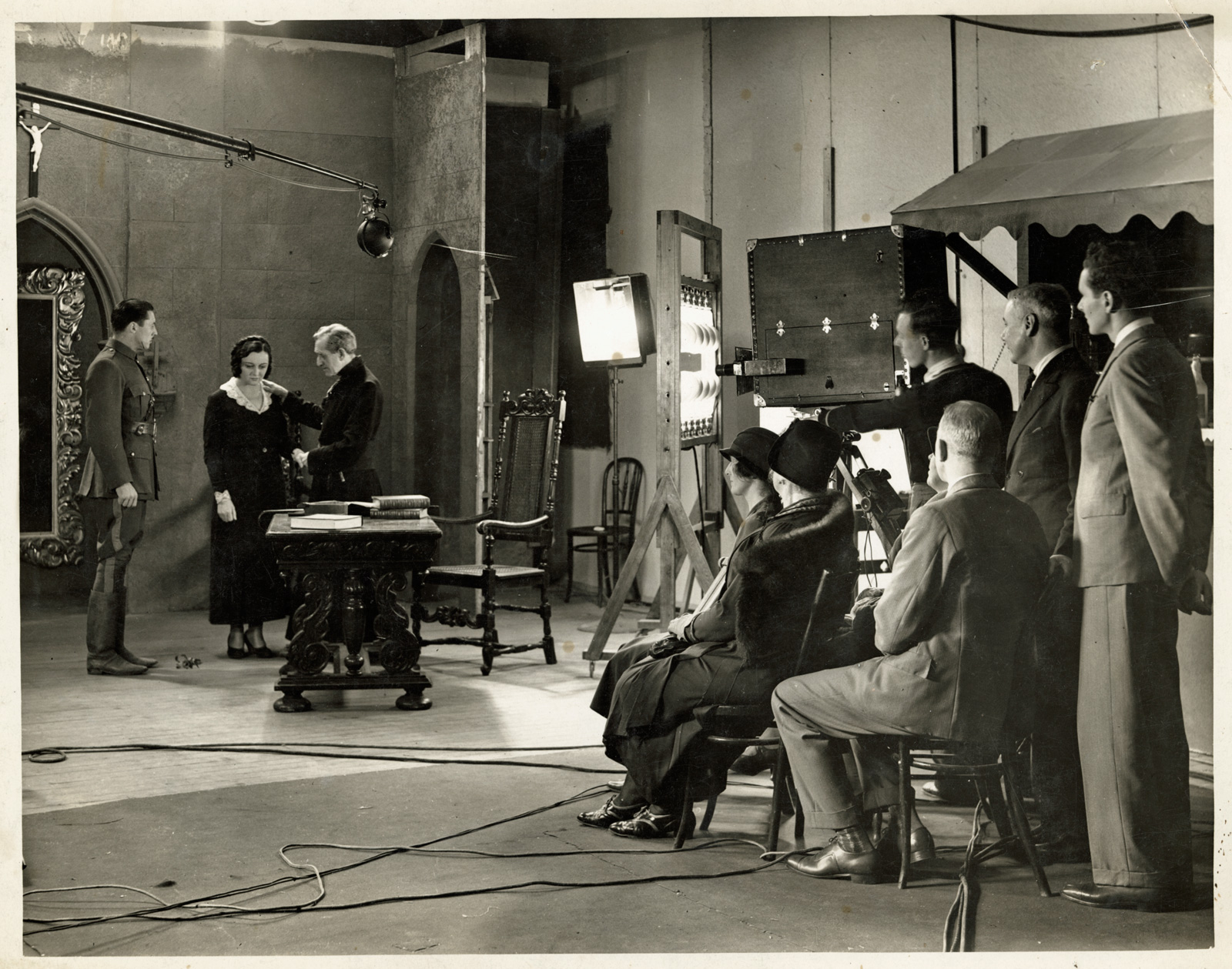
Paulette McDonagh directing actors Isabel McDonagh (billed as Marie Lorraine), Arthur Greenaway and Campbell Copelin in Two Minutes Silence (1932). NFSA title: 641865
Television
The NFSA aims to acquire a representative sample of all Australian television productions screened since 1956. The following is a selection of the programs we desire most:
-
Any programs from the earliest days of Australian television broadcasting that were produced in the pre-videotape era between 1956 and 1960.
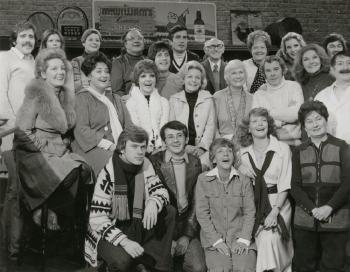 https://www.nfsa.gov.au/sites/default/files/03-2019/1127743.jpg
https://www.nfsa.gov.au/sites/default/files/03-2019/1127743.jpgNumber 96 cast photo, (1974). Cash-Harmon Productions. NFSA title: 1127743 - Music television shows for which no episodes are held including Jukebox Jury (1961-67), Surfsound (1964), Kommotion (1965-67), It’s All Happening (1966), Action (1966), Turning On (1969) and Rock ‘n’ Roll Circus (1975-76) amongst many others.
- The Private World of Miss Prim (NLT Productions, 1966) – sitcom starring Dawn Lake, 'Australia’s Lucille Ball'. Only the pilot episode of this 11-episode series survives.
- Hunter (Crawford Productions, 1967-69) – The ambitious espionage series is considered ahead of its time. Four of the 65 episodes have yet to be located.
- Young Talent Time (Lewis-Young Productions, 1971-88) – Only the first episode and a handful of others survive from the 1971-78 era of the long-running talent series hosted by Johnny Young.
- The Spoiler (Gemini Productions, 1972) – All 13 episodes of this gritty, groundbreaking drama featuring anti-hero Jim Carver (Bruce Barry) are missing.
- Number 96 (Cash-Harmon Productions, 1972-1977) – Though a complete run of all the colour editions survives, the NFSA retains only 19 of the 584 black-and-white episodes of this landmark, era-defining series.
- The Drifter (Swan Television, 1973-74) – A Western Australian-produced drama starring Alan Cassell of which the NFSA holds only a viewing copy of the first 2 of 22 episodes.
- Blankety Blanks (Reg Grundy Productions, 1977-78) – Fewer than 20 episodes of the 440 produced of Graham Kennedy’s top-rating game show are held.
- Examples of Australian regional television programs that are not held by the NFSA and produced in the black-and-white era (1956-1974).
Radio
- Any recordings from regional Australia to supplement the NFSA’s representative recordings from the large metropolitan stations.
- Any Australian radio recordings from the 1920s and 1930s.
- Any Women’s Sessions to add to what is already in the NFSA collection.
- Any episodes of early radio serials Big Sister and Crossroads of Life and radio plays from Macquarie Radio Theatre.
- 2GB programs presented by Anne Deveson.
- 2GB programs presented by Brian White.
- Any programs presented by Andrea (Dorothy Hetty Fosbury Jenner), former Queen of Sydney Radio.
- Any examples of 1960s Top 40 radio programs by presenters like Ward Austin, Bob Francis, Sammy K, Stan Rofe, Bob Rogers, Brian Taylor, Graham Webb and Tony Withers.
Sound
- Austral Duplex recordings from the early 1920s. These were the first disc records manufactured in Australia. They were not very durable, so few have survived – we hold only four examples.
- Early retail recordings from local labels Federal Cylinders and the Australian Record Company. In the first decade of the 20th century two enterprising businesses set about supplying locally made cylinder records. Few of these records survive and they are primarily in private collections.
- Slim Dusty’s unreleased demonstration recordings made before his first commercial release in 1946. These process recordings were pressed in very limited quantities, but a few are known to exist in private collections. See Slim Dusty material the NFSA already holds.
- Any recording of the broadcast of Dame Nellie Melba’s funeral procession. Melba’s death in 1931 was front-page news in Australia, New Zealand, the UK and Europe, and we know that her funeral procession was filmed and broadcast on radio. It is just possible that someone recorded part of that broadcast. See Dame Nellie Melba material the NFSA already holds.
- The Overlanders (Trevor Lucas, Reality Records, 1966). This early selection of Australian folk music is very rare. See The Overlanders material the NFSA already holds.
- Any recordings of extinct wildlife or lost soundscapes not already in public collections.
Documents, objects and artefacts
- Australian music fashion, such as original costumes worn by AC/DC, Skyhooks, Jeff Duff and Johnny O’Keefe.
- Documentation relating to the careers of distinguished, contemporary female Australian performers, including Olivia Newton-John, Toni Collette, Cate Blanchett, Christine Anu, Rachel Griffiths, Deborah Mailman and Marcia Hines.
- Complete historical corporate papers relating to Greater Union, Australia’s largest and oldest film exhibitor, and the Australian Record Company, founded in the late 1930s, which became one of Australia’s principal music recording and distribution companies from the 1950s to the 1970s.
- Animation cels for the early works of Australian cartoonist Harry Julius (1885–1938), including the Cartoons of the Moment series from the 1910s; and animator Eric Porter (1911–83), such as Willie Wombat 1939. See Cartoons of the Moment material the NFSA already holds.
- Joan Sutherland’s 1961 Grammy Award for Best Classical Performance (the first Grammy awarded to an Australian artist).
- Scripts for both film and radio of all vintages with the directors’ or performers’ annotations.
- Stills, scripts and memorabilia for the remaining ‘lost’ Australian feature films 1900–1980.
Why search for 'lost’ film?
The NFSA aims to acquire original image and sound negatives, or their more recent digital equivalents, of Australian feature films, documentaries and short films. These components can be used for preservation and any necessary restoration, allowing the creation of new duplicate images and sound negatives in the lead-up to a new print.
The many copies of a film screened in cinemas are printed photochemically from a 35mm or 16mm negative, usually a duplicate made from the original edited camera negative. Prints over time become scratched, faded, shrunken and fragmented, and their soundtrack worn. Even if a print is in perfect condition, it is unsuitable for copying or preservation, and when a battered print is the sole survivor of a feature film, this is far from ideal. Sometimes negatives are re-edited to shorter versions of the film for later release or use overseas, and the original full-length version is hard to reproduce.
More than 90 per cent of all Australian films made during the pre-1930 silent era are now missing. Their survival chances diminish with each passing year unless an archive, distributor or collector holds them. The survival options for films made since 1951 are far better. Not only have these films been made on safety stock, but many of their filmmakers, or people who knew them, are still around to provide valuable leads.
Even films several years old can be in jeopardy if a film has not been kept under stable storage conditions (in vaults with customised temperature and humidity controls). This also applies to films shot digitally. With digital production, projection and archiving now a reality, archives face the increasing challenge of deciding what to preserve, how to preserve it, and how to migrate digital-born material in the face of rapid format change.
The NFSA’s Collection Policy requires the NFSA to preserve a film in its original form for as long as the technology of that form can be supported. While a film might turn up regularly on television or DVD, more is needed to guarantee that it is being preserved.
The National Film and Sound Archive of Australia acknowledges Australia’s Aboriginal and Torres Strait Islander peoples as the Traditional Custodians of the land on which we work and live and gives respect to their Elders both past and present.
